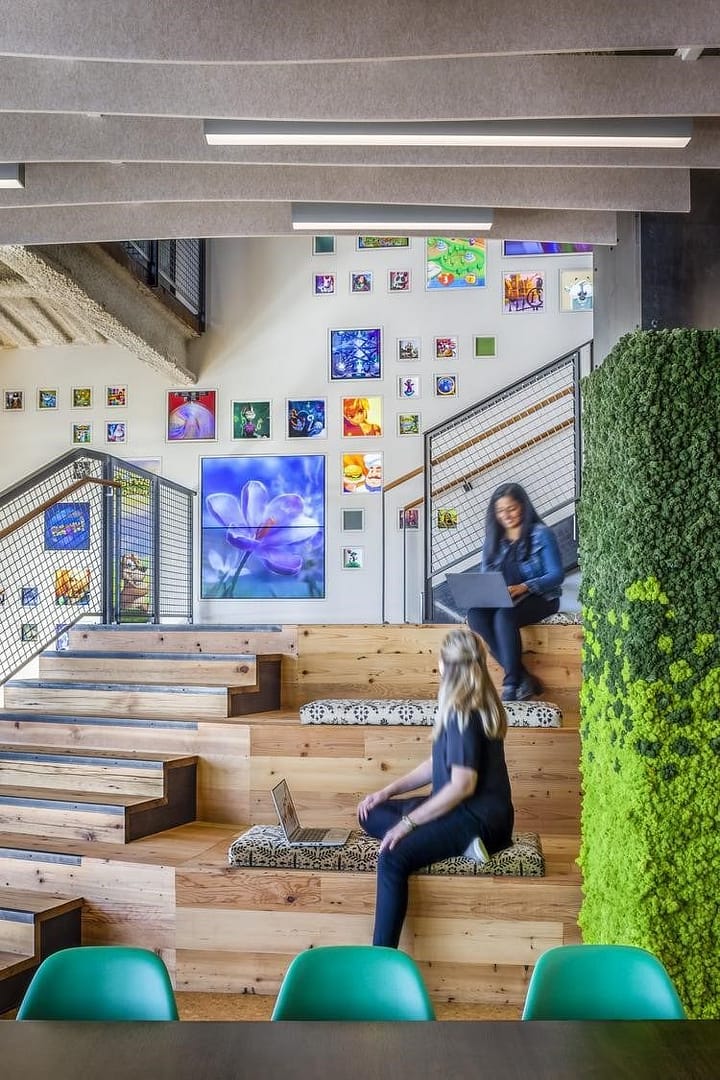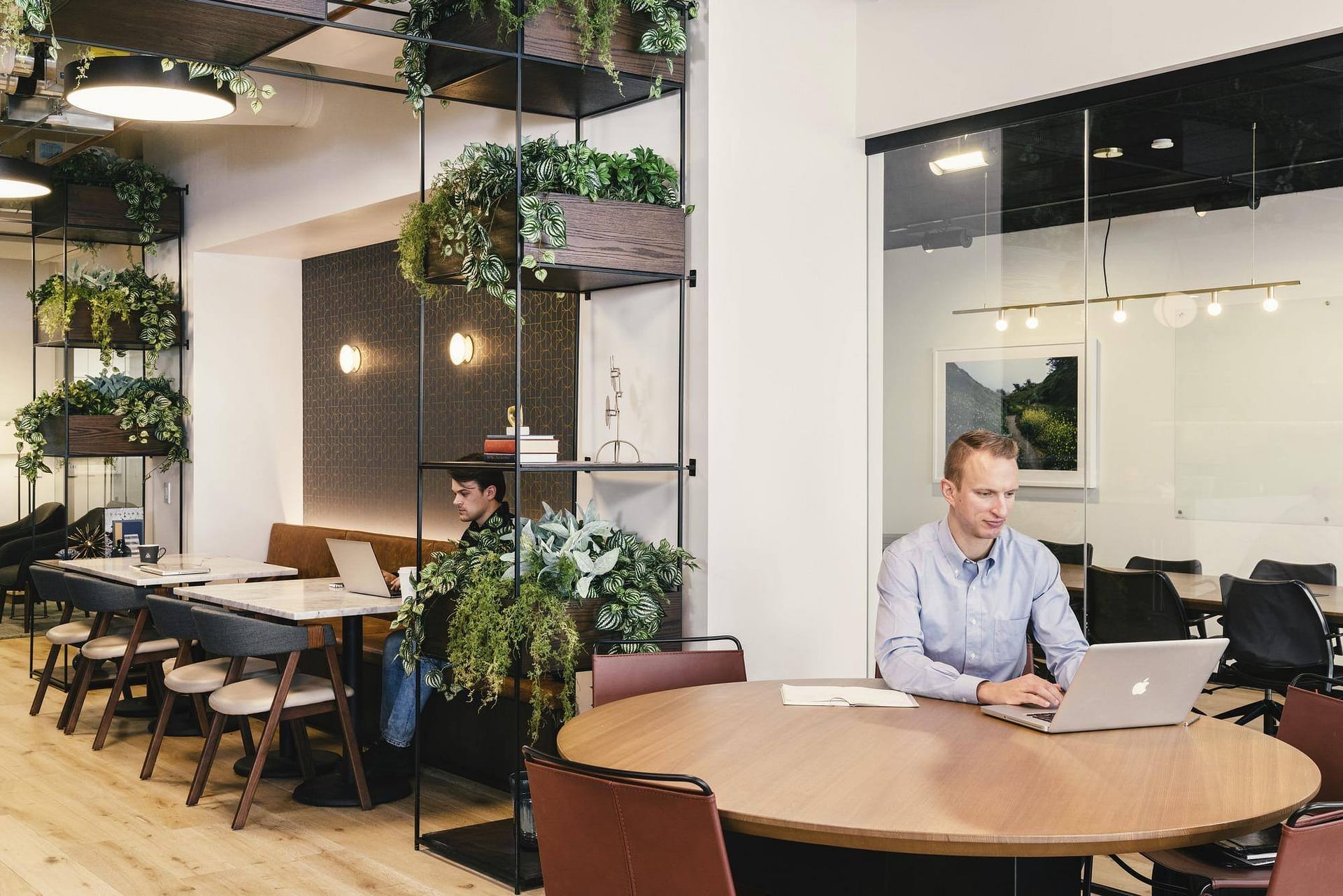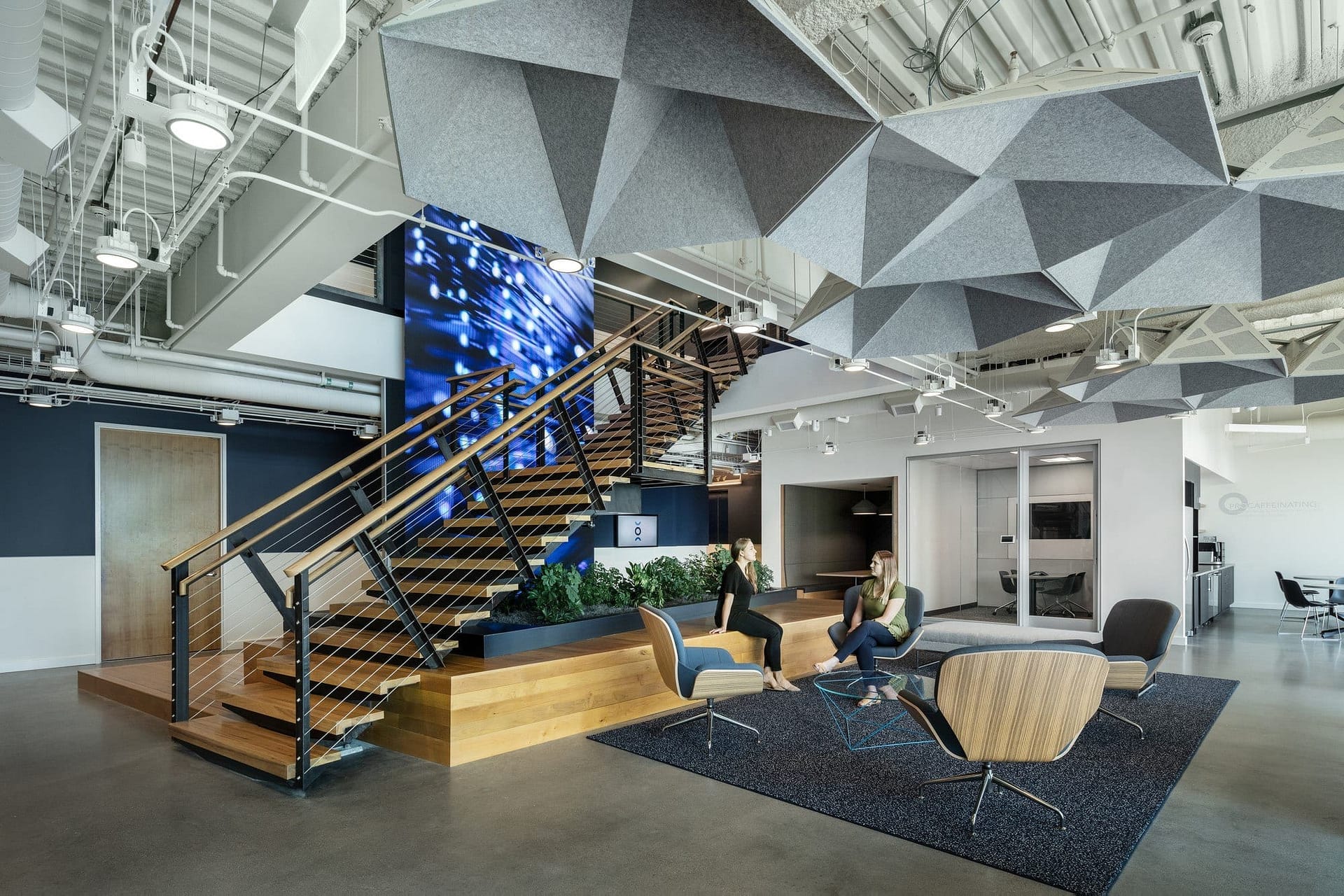(and Why It Probably Isn't Your Open Office's Fault)
Mary Lee Duff, LEED AP, IIDA | Director of Ecos Studio
&
Grzegorz Kosmal AIA, LEED AP BD+C | Design Director

Does your workplace promote collaboration? Confidential Client, Seattle. Photography © Andrew Buchanan.
Collaborative spaces have come under fire as of late, and more often than not, the fingers are being pointed at open offices. This recent outcry has led some to doubt if collaboration itself isn’t to blame.
And, in truth, there are certainly shortcomings in how workplaces are being made to be more collaborative. Unfortunately, many of the loudest voices in this argument against the open office often rely upon minuscule sample sizes or data that doesn’t pertain to the typical workplace at all. One can hardly blame them—more often than not, those outside the industry are forced to compare apples to oranges, having to use data that compares workspaces with vastly different workplace strategies, organizational cultures, change management processes, or are even in different industries—all within a reasonable sample size.
But, it would be folly to disregard the simple truth—that a notable number of individuals are having negative experiences within the open office, and finding it hard to collaborate. There may be some instances where the physical design of the space is to blame. But, considering that open offices have been successfully utilized for decades, what other factors could make efforts to establish a collaborative culture fail within an open office? We posed this question to IA’s Senior Director of Strategy Mary Lee Duff, LEED AP, IIDA and IA Design Director Grzegorz Kosmal, AIA, LEED AP BD+C , who lent us some industry insights that help to answer this question.
Change Management Didn’t Occur

Change management is especially important when employees are presented with novel workspaces or asked to transition to a different style of desking. Big Fish Headquarters, Seattle. Photography © Sherman Takata.
While a new workplace doesn’t always entail sweeping changes, it does often involve new categories of space. Director of Strategy Mary Lee Duff would argue that, with new spaces, come new processes for utilizing those areas. “Especially when transitioning to a free address system, a lack of communication and change management can cause chaos in a new environment.” Unfortunately, all too often new spaces are introduced without giving teams the information for making the best use of them. “Because people aren’t used to using these new spaces, they either won’t use or will do so incorrectly, and in that situation, they tend to revert back to how they worked before” she adds. Simply put, when employees engage in closed office behaviors in an open office environment, most of the benefits of either system of work are lost, and without proper change management, the transition to the open office isn’t likely to go smoothly.
A Lack of Executive Buy-In
Sometimes change does genuinely start from the top, and the transition to an open space is undoubtedly one of those situations. The cornerstones of an open office set up are mobility and choice, and when work isn’t conducted in a way that supports this, the flexibility of an open office can be severely hindered.
“It’s important that executives are a part of demonstrating collaboration in an open and transparent fashion,” remarks Duff. “When they don’t move about their employee spaces it’s noticed—it’s not ideal when people have to come to them and feel generally uninvited.” Executives and mid-level management are most responsible for enforcing changes in how work is done, and leading by example. “It is crucial to have both executive and mid-level management buying in to the design process so they can understand where these solutions are coming from, and therefore can champion them” adds Kosmal. “A lot of times, senior management has been influenced by a completely different set of parameters regarding how to conduct work and relate to their coworkers. It can be difficult to adjust when you’ve spent your career working towards that corner office, and suddenly there’s no corner office.”
It’s important that executive and mid-level management work styles are represented in the early strategy sessions. “Some managers may have a problem with not seeing people that they’re interacting with” says Grzegorz. “Right now the agile process is quick sprints, giving a lot of autonomy to the teams, quick feedback loops—basically, teams are autonomous, and a lot of management may involve sitting at your desk supervising teams from a distance, rather than the physical presence typical of management styles in years past.” He goes on to describe how results-oriented management, rather than presence-oriented management is generally more effective in the modern workplace, and that if this isn’t addressed early on in the project, it’s unrealistic to expect either the workplace or the management teams within it to work flexibly.

"
If you’re trying to promote collaboration in an open space, then you’ve got to equip people to be able to find focus, or put on a headset—and that becomes the equivalent of closing a door.”
MARY LEE DUFF, LEED AP, IIDA
Your Workplace Wasn’t Designed in Such a Way That it Reflects How People Work Inside It
Space does not support open collaboration because it is all open; people are sensitive to disruption. A proper open plan should enable teams to find spaces where they can step away and collaborate on an ad hoc basis, or easily find moments of solitude when that makes sense.

Dedicated quiet spaces, private booths, and phone rooms (like the one pictured above) are just a few of the space types that should be provided to employees in an open office environment to support less collaborative work moments. Virgin Voyages Headquarters, Plantation, FL. Photography © Robin Hill.
There is such a thing as too much open space. Eventually, the space becomes distracting in its vastness, but more than that, the lack of neighborhoods or meeting spaces can make teams sensitive about disrupting one another, effectively quashing collaboration. If support centers or meeting areas are too far away, they’re not utilized—which further diminishes collaboration.
That’s not to say that one of every space type should be within view of a given work station. Amenity spaces, tech bars, and similar spaces have enough draw to bring individuals from a far greater distance. But heatmapping studies back the notion that support spaces that are located more than 60 feet from a given workstation tend to go unused.
But an open space can still kill collaboration, no matter its size, if proper acoustic conditions are not met. “People can get hypersensitive to sound if it’s too quiet, but on the opposite end of the spectrum, a space that is too noisy presents a problem too” comments Mary Lee Duff. “It comes down to good planning that creates a balance between collaboration and focus work.” Understanding the work that will occur in the space can allow a workplace strategy team to determine what acoustic conditions to expect, and how to plan for efficient neighborhoods where teams work together in an activity based environment.
Understanding acoustic conditions and noise norms in an office allows designers to deliver unique solutions to ensure that collaboration isn’t hampered by noise levels. Confidential Client. Photography © Jose F. Parreño.
Your Teams Do Not Have the Right Tools
Technology can make all the difference between a successful and unsuccessful brainstorming meeting. And in some industries, that can have a drastic effect on workflow. “When your team isn’t given the resources it needs to interact and to preserve and share the results of collaboration sessions, such interaction can be lost—especially in teams where a lot of collaboration happens remotely” advises Kosmal. “That disrupts collaboration and can slow the whole team down.” Digital whiteboards, cloud-connected smart scanning applications, and similar technologies can all help overcome this difficulty but aren’t always available to employees. In conjunction with this technology, it is of paramount importance that teams establish analog processes that enable them to utilize entire walls and maintain visual access to such information, as it is vital to the process of ideation.
“Collaboration can happen anywhere oftentimes because the technology that supports it has been embedded within the space” responds Mary Lee Duff. “The thoughtful use of technology enables ease of collaboration and facilitates a more fluid workstyle.” Duff uses the examples of phone rooms that are equipped with video conferencing technology, and hallways that support impromptu meetings with digital displays as examples of how technology can be a very important attribute of the collaborative workplace.
The same logic applies to wireless headsets and universal connectivity. It can be difficult to enable the free flow of people and information within a space if users are nailed to their desks. “In the Capital One Headquarters, for example, we designed a loop so that people can take conference calls and walk around the office while on a conference call so that they’re not disruptive and get some necessary movement,” Kosmal recalls. Without being provided with wireless headsets, though, users find it inherently more difficult to find the right setting for phone calls, and take advantage of private spaces or purpose-built loops in the building plan, contributing to further disruption in the open workspace.

It is only with completely wireless technology that teams can make the most of a flexible workplace. Industrious, Portland. Photography © Julia Robbs Photography.
Your Organization Has the Wrong Internal Policies
In some management methodologies, there is a focus on physical presence and oversight. This can be an issue of trust, of control, or a byproduct of the type of work being done. But, regardless of the source, the open office is more conducive to a flatter and more transparent management style. “When control is relinquished then staff can relax and choose where and how to work so they can succeed” comments Kosmal, relying on his 25 years of workplace design experience. But, for this to occur, staff must have access to alternative spaces in the first place. Mary Lee Duff uses the example of the recreation room. “Teams we’ve worked with tell us that game rooms help them to get into a more relaxed mindset that helps them get into a more creative mindset.” she recalls. “There’s neuroscience behind how spaces like these help employees to lower stress, work more efficiently, and even use the space for impromptu meetings.” The question of access to a wider variety of spaces also extends to how long employees can access those spaces, and whether they can be reserved for multiple days (allowing notes and other resources to be left overnight), or if there is space that can be relied upon at a moment’s notice.
Other policies, more closely tied to etiquette can impact collaboration, too. With an open office comes a shared understanding of acceptable noise levels, for instance. Are expectations in line with the workplace strategy? This is an important thing to establish during the early stages of the project, and relevant stakeholders must be included in the discussion.

Accepted workplace noise level norms can have a tremendous impact on collaboration. It’s important that this is established with the team, enabled by the design of the space, and communicated to those going to inhabit the space. Confidential Client, Denver. Photography © James Florio.
But the impact of internal policies on workplace collaboration extends far past etiquette. Kosmal would argue that collaboration is a state of mind much more than it is a workplace trend or management practice. “It is closely aligned with other personal qualities like curiosity, inclusion, respect for others, shared values...in hierarchical settings collaboration is often diminished as competition, status and privilege inhibit the flow of information. Leadership (not just being a boss) plays an important role in setting the right tone for a collaborative environment.” Duff and Kosmal both agree that if those values don’t exist, collaboration doesn’t either.
In Summary
It’s true that design can make or break collaboration in the workplace. Designers and strategists need to account for things such as work types, management styles, office etiquette, and all manner of other details when designing a space—but even the perfectly-designed space can fail to foster connectivity. As true as it is that design can bring teams together or pull them apart, it is also equally true that management styles, workplace cultures, technology, and change management can have the same effects, and that statements like “Open offices don’t foster Collaboration” are overly simplistic. If the move to the open environment is motivated by cost-savings and does not really encompass an effort to improve workplace culture and address the needs of the team, the resulting space will not support collaboration. Instead, the result is a workspace that relies on old management structures and processes that are housed in an environment that is not compatible with them.

